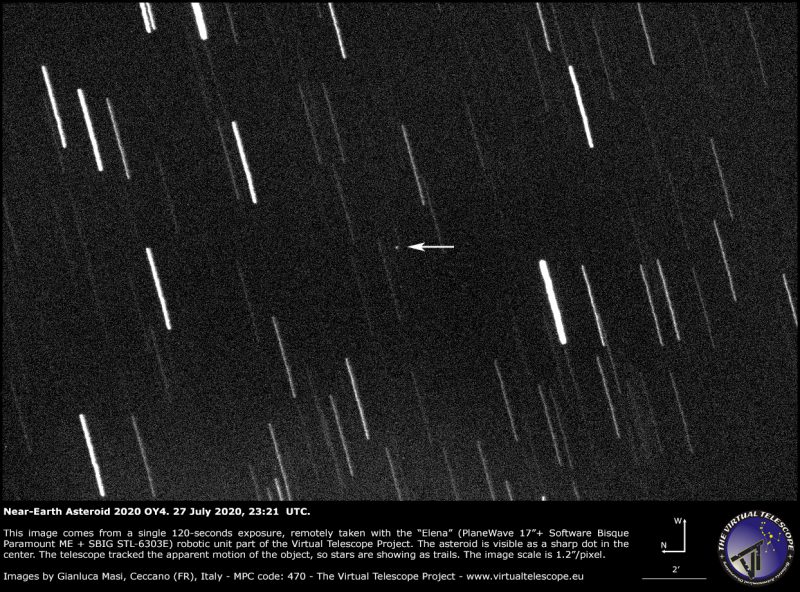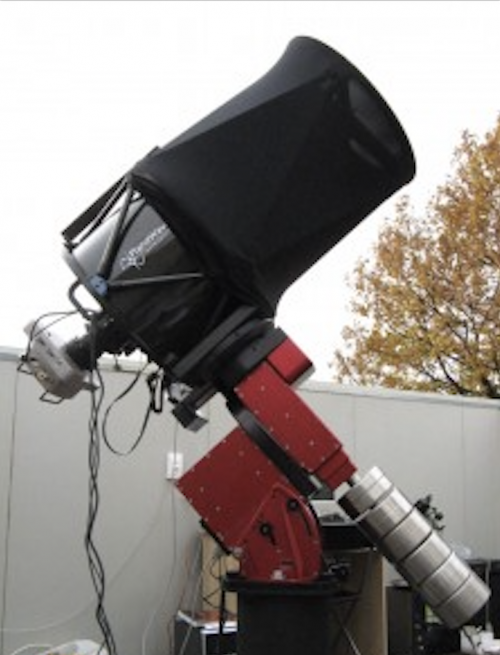

View larger. | Near-Earth asteroid 2020 OY4 on July 27, 2020. At the imaging time, the asteroid was about 155,000 miles (250,000 km) from Earth, 2/3s of the lunar distance, and it was still safely approaching us. Image via the Virtual Telescope Project.
Earlier today (July 28, 2020), near-Earth asteroid 2020 OY4 had a extremely close, but safe, encounter with our planet, reaching a minimum distance from the Earth of about 26,000 miles (42,000 km), less than 11% of the average distance of the moon. We managed to capture its image as it swept past.
This space rock is estimated to be about 7.5 to 17 feet (2.3 to 5.2 meters) across. It reached its minimum distance from us earlier today on July 28, 2020, at 05:32 UTC (translate UTC to your time). Of course, there were no risks at all to our planet. According to NASA’s Jet Propulsion Laboratory:
Space rocks smaller than about 25 meters (about 82 feet) will most likely burn up as they enter the Earth’s atmosphere and cause little or no damage.
If a rocky meteoroid larger than 25 meters but smaller than one kilometer ( a little more than 1/2 mile) were to hit Earth, it would likely cause local damage to the impact area.
The Mt. Lemmon survey discovered the asteroid on July 26, 2020.
The image above comes from a single, 120-second exposure, remotely taken with the “Elena” (PlaneWave 17?+Paramount ME+SBIG STL-6303E) robotic unit available at Virtual Telescope.
The telescope tracked the fast apparent motion of the asteroid. This is why stars show as long trails, while the asteroid looks like a bright and sharp dot of light in the center of the image, marked by an arrow.

The Planewave 17?-f/6.8 (432/2939 mm) Corrected Dall-Kirkham Astrograph telescope of the Virtual Telescope Project was used to capture the image above of asteroid 2020 OY4. It is named “Elena” for Gianluca Masi’s mother. Read more about this telescope.
Bottom line: Image and information about asteroid 2020 OY4, which swept within 11% of the moon’s distance on July 28, 2020.
from EarthSky https://ift.tt/2PfvOkJ


View larger. | Near-Earth asteroid 2020 OY4 on July 27, 2020. At the imaging time, the asteroid was about 155,000 miles (250,000 km) from Earth, 2/3s of the lunar distance, and it was still safely approaching us. Image via the Virtual Telescope Project.
Earlier today (July 28, 2020), near-Earth asteroid 2020 OY4 had a extremely close, but safe, encounter with our planet, reaching a minimum distance from the Earth of about 26,000 miles (42,000 km), less than 11% of the average distance of the moon. We managed to capture its image as it swept past.
This space rock is estimated to be about 7.5 to 17 feet (2.3 to 5.2 meters) across. It reached its minimum distance from us earlier today on July 28, 2020, at 05:32 UTC (translate UTC to your time). Of course, there were no risks at all to our planet. According to NASA’s Jet Propulsion Laboratory:
Space rocks smaller than about 25 meters (about 82 feet) will most likely burn up as they enter the Earth’s atmosphere and cause little or no damage.
If a rocky meteoroid larger than 25 meters but smaller than one kilometer ( a little more than 1/2 mile) were to hit Earth, it would likely cause local damage to the impact area.
The Mt. Lemmon survey discovered the asteroid on July 26, 2020.
The image above comes from a single, 120-second exposure, remotely taken with the “Elena” (PlaneWave 17?+Paramount ME+SBIG STL-6303E) robotic unit available at Virtual Telescope.
The telescope tracked the fast apparent motion of the asteroid. This is why stars show as long trails, while the asteroid looks like a bright and sharp dot of light in the center of the image, marked by an arrow.

The Planewave 17?-f/6.8 (432/2939 mm) Corrected Dall-Kirkham Astrograph telescope of the Virtual Telescope Project was used to capture the image above of asteroid 2020 OY4. It is named “Elena” for Gianluca Masi’s mother. Read more about this telescope.
Bottom line: Image and information about asteroid 2020 OY4, which swept within 11% of the moon’s distance on July 28, 2020.
from EarthSky https://ift.tt/2PfvOkJ

Aucun commentaire:
Enregistrer un commentaire